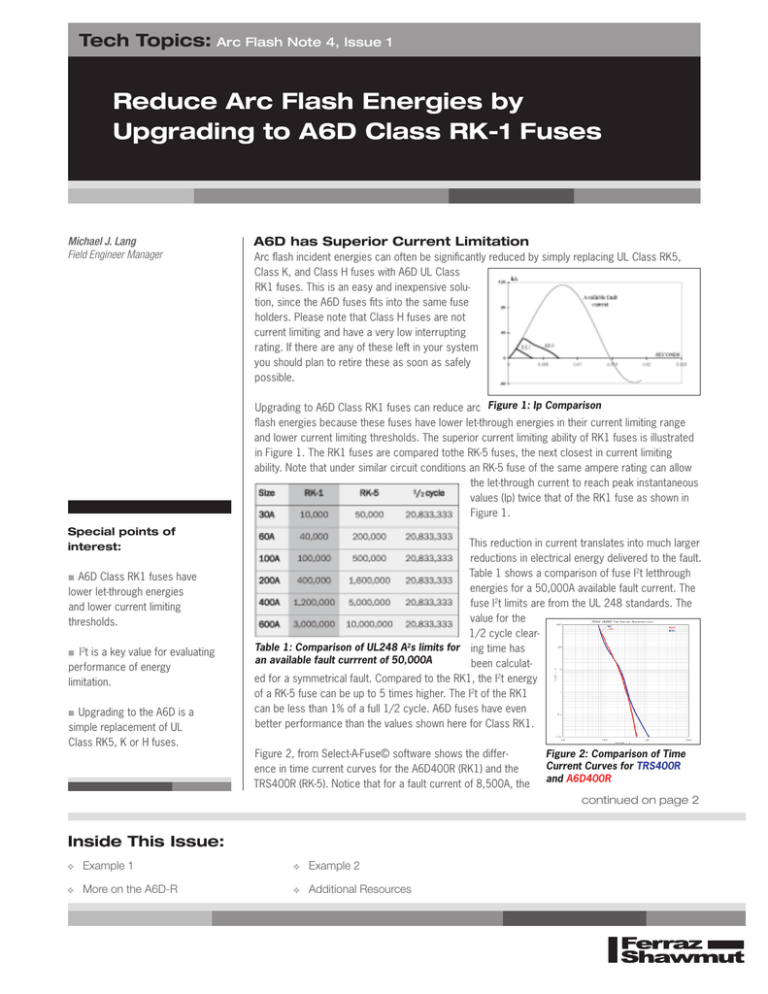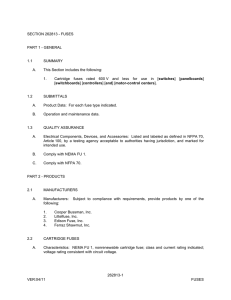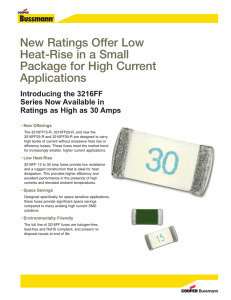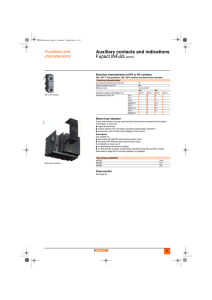
Tech Topics: Arc Flash Note 4, Issue 1
Reduce Arc Flash Energies by
Upgrading to A6D Class RK-1 Fuses
Michael J. Lang
Field Engineer Manager
A6D has Superior Current Limitation
Arc flash incident energies can often be significantly reduced by simply replacing UL Class RK5,
Class K, and Class H fuses with A6D UL Class
RK1 fuses. This is an easy and inexpensive solution, since the A6D fuses fits into the same fuse
holders. Please note that Class H fuses are not
current limiting and have a very low interrupting
rating. If there are any of these left in your system
you should plan to retire these as soon as safely
possible.
Upgrading to A6D Class RK1 fuses can reduce arc Figure 1: Ip Comparison
flash energies because these fuses have lower let-through energies in their current limiting range
and lower current limiting thresholds. The superior current limiting ability of RK1 fuses is illustrated
in Figure 1. The RK1 fuses are compared tothe RK-5 fuses, the next closest in current limiting
ability. Note that under similar circuit conditions an RK-5 fuse of the same ampere rating can allow
the let-through current to reach peak instantaneous
values (Ip) twice that of the RK1 fuse as shown in
Figure 1.
Special points of interest:
A6D Class RK1 fuses have
lower let-through energies
and lower current limiting
thresholds.
■
■ I2t
is a key value for evaluating
performance of energy
limitation.
Upgrading to the A6D is a
simple replacement of UL
Class RK5, K or H fuses.
■
This reduction in current translates into much larger
reductions in electrical energy delivered to the fault.
Table 1 shows a comparison of fuse I2t letthrough
energies for a 50,000A available fault current. The
fuse I2t limits are from the UL 248 standards. The
value for the
1/2 cycle clearTable 1: Comparison of UL248 A2s limits for ing time has
an available fault currrent of 50,000A
been calculated for a symmetrical fault. Compared to the RK1, the I2t energy
of a RK-5 fuse can be up to 5 times higher. The I2t of the RK1
can be less than 1% of a full 1/2 cycle. A6D fuses have even
better performance than the values shown here for Class RK1.
Figure 2, from Select-A-Fuse© software shows the difference in time current curves for the A6D400R (RK1) and the
TRS400R (RK-5). Notice that for a fault current of 8,500A, the
Figure 2: Comparison of Time
Current Curves for TRS400R
and A6D400R
continued on page 2
Inside This Issue:
<
Example 1
<
Example 2
<
More on the A6D-R
<
Additional Resources
Tech Topics: Arc Flash Note 4, Issue 1
Page 2
TRS400R will take 1-2 cycles to clear, while
the A6D400R curve is less than 0.01 seconds
because it is current limiting at this current
level. This is due to the lower current limiting
threshold. For more information on current limitation see Arc Flash Note 2. The examples on
the next two pages illustrate how upgrading a
Class RK5 fuse to Ferraz Shawmut’s Amp- Trap
2000® A6D Class RK1 fuse can dramatically
reduce arc flash energies.
Figure 4: Revised one-line diagram
Example 1
“The dramatic
reduction in
Situation
In the application represented in Figure 3, a
main lug only panel fed by a 480V feeder is
protected by a TRS600R Class RK5 fuse. The
short circuit study predicts an available fault
current of 19,800A at the line terminals of the
panel. For an incident energy calculation, you
must use the characteristics of the upstream
overcurrent protective device for the available
fault current at the panel.
incident energy
in this case
greatly reduces
As Figure 5 illustrates, the A6D600R Class RK1
fuse will reduce the anticipated incident energy
- under the same conditions - to approximately
0.3 cal/ cm2. With its superior current limitation and a lower current limiting threshold, the
600A Class RK1 current limiting fuse dramatically reduces the expected arc fault incident
energy.
The PPE requirements for workers needing to
access this panel in an energized state would
be reduced from Category 2 to Category 0.
The dramatic reduction in incident energy in
this case greatly reduces the probability of a
worker being injured.
the probability of
a worker being
injured.”
Figure 3: One-line diagram
Tests in Ferraz Shawmut’s high power lab have
shown incident energies at 18 inches to be
in excess of 4 cal/cm2 at the line terminals
for this available fault current. Analysis using
equations from NFPA70E and IEEE Std 1584™
- 2002 IEEE Guide for Performing Arc-Flash
Hazard Calculations yield comparable values. If
a worker were to access this panel in an energized state, they would need to be protected
with at least category 2 PPE.
Recommendation
To effectively reduce the arc flash incident energy in this scenario, we suggest replacing the
TRS600R Class RK5 fuse with Ferraz Shawmut’s
A6D600R Class RK1 fuse as shown in Figure 4.
Figure 5: Incident energy chart for A6D Fuses.
No special adapter hardware is required for
this solution since the dimensions of the RK1
are identical to that of the RK5. The nominal
cost of this upgrade makes it an excellent
investment in worker safety.
Reduce Arc Flash Energies by
Upgrading to A6D Class RK-1 Fuses
Tech Topics: Arc Flash Note 4, Issue 1
Example 2
Page 3
Situation
In the application represented in Figure 6, a
control panel is fed by a 480V feeder, which
is protected by a 1200A circuit breaker. The
panel’s main fuses are 400A Class RK5 fuses.
of 18 inches for 28.8 kA available fault current
using equations from IEEE 1584™. If a worker
were to access this panel in an energized
state, that worker would need to be outfitted
with PPE rated for Hazard / Risk Category 3
per NFPA70E.
Figure 6: One-line diagram
Recommendation
To effectively reduce the arc flash incident energy in this scenario, we suggest replacing the
400A Class RK5 fuse with Ferraz Shawmut’s
A6D400R Class RK1 fuse and eliminating the 6
cycle delay of the upstream circuit breaker. As
illustrated on page 1, the lower current limiting
threshold of the A6D fuse results in a time
current characteristic with the lower part of the
curve to the left of the Class RK5 fuse. Figure
8 shows how the time current characteristic
of the A6D400R Class RK1 fuse allows for
coordination with the upstream circuit breaker
with the short time delay removed.
“No special
adapter
A short time delay of 6 cycles has been selected for the circuit breaker to coordinate its
trip characteristics with the largest fuses in the
panel (see Figure 7). The short circuit study
predicts an available fault current of 28.8 kA at
the line terminals of the panel. For an incident
energy calculation, you must use the characteristics of the upstream overcurrent protective
hardware is
required for this
solution since the
dimensions of the
RK-1 are identical
to that of the
RK-5.”
Figure 8: Plot from EasyPower Software
Figure 7: Plot from EasyPower Software
device for the available fault current at the
panel. The calculated incident energy at the
line terminals of the panel would be approximately 10.2 cal/cm2 for a working distance
Recalculating with the new total clearing time
of the breaker yields a predicted incident
energy of approximately 2.9 cal/cm2. The
PPE requirements for workers needing to
access this panel in an energized state would
be reduced from Category 3 to Category 1.
The reduction in clearing time also reduces
the flash protection boundary from 65 inches
to 30 inches. No special adapter hardware is
required for this solution since the dimensions
of the RK1 are identical to that of the RK5. The
nominal cost of this upgrade makes it an excellent investment in worker safety.
Reduce Arc Flash Energies by
Upgrading to A6D Class RK-1 Fuses
Tech Topics: Arc Flash Note 4, Issue 1
Page 4
Amp-Trap 2000® A6D Class RK1 Fuse
The best choice for upgrading existing applications of 600 amps and less, the A6D offers excellent
current limiting performance for short circuits and time delay for overloads. Its dimensions allow for
simple upgrades of existing Class H, Class K and Class RK5 fuses.
Best degree of arc energy mitigation. When it comes to low
current limiting thresholds and low let-through energies, there is no
better alternative than the A6D. When applied so that the fuses will
be current limiting for arc fault currents, incident energy at working
distances of 18” are typically less than 0.25 cal/cm2.
Easy upgrade to Class RK1 protection. This simple change
can dramatically reduce incident energies for workers exposed
to energized equipment. Upgrading is easy because Class RK1
fuses have the same overall dimensions as Class RK5, Class K
and Class H fuses. See Figure 9. The rejection blades and ferrules
of the RK classes will fit directly into the non-rejection blocks that
accept Class K and H fuses. To ensure that RK1 fuses are not
replaced with RK5 (or lesser) fuses, look to our inventory analysis
and upgrade services. By streamlining and upgrading your inventory and training workers in circuit protection safety, you can help
prevent replacement errors from occurring.
Easier system coordination. With Amp-Trap 2000® fuses,
selective coordination is ensured by maintaining a 2:1 ratio
between upstream and downstream ampere ratings.
Type “2” protection for motor starters. The A6D has been
certified by starter manufacturers to provide Type “2” (No-Damage)
short circuit protection for NEMA and IEC starters.
Figure 9: A6D-R® pictured to
the right can replace Class
H, K and RK-5 fuses.
Reliable performance. The A6D’s time-delay feature (for overloads) and short circuit design allow
temporary low-level overcurrents like inrush currents and motor starting currents to pass without
unnecessary openings.
For more on improving
overcurrent protection
with fuses, visit
our website at
us.ferrazshawmut.
com.
374 Merrimac Street,
Newburyport, MA 01950
T: 978-462-6662
F: 978-462-0181
© 2007 Ferraz Shawmut. All rights reserved.
TT-AF4-001 2/07 OS Q50
Additional Resources
Arc Flash Note 1: Multiple Hazards of Arcing Faults.
Arc Flash Note 2: Reducing Arc Energies with Current Limiting Fuses.
< Arc Flash Note 3: Arc Flash Hazard Analysis
< Advisor: Selective Coordination with Current Limiting Fuses
< Type 2 Motor Starter Protection Fuse Guide
< MRO Asset Protection: Fuse Inventory Consolidation Service
< AmpTrap2000® Brochure
<
<





